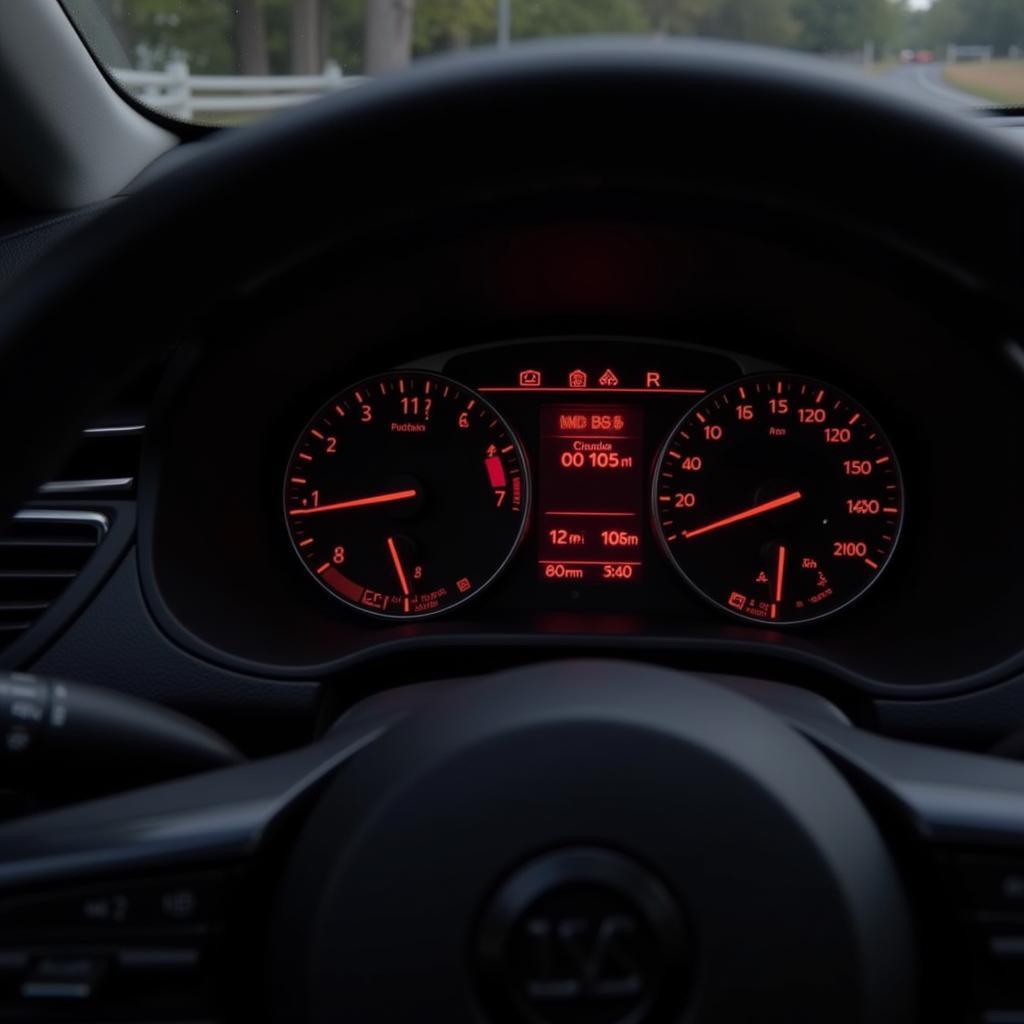So, your Nissan Maxima’s brake warning light has decided to grace you with its presence. Not exactly the kind of dashboard illumination you were hoping for, right? Don’t panic just yet. While this light can signal a serious issue, it could also be something minor. Let’s dive into the common reasons why your Maxima’s brake warning light might be on and, more importantly, how to address them.
Common Causes of a Maxima Brake Warning Light
There are several reasons why your Maxima’s brake warning light might illuminate. Some are simple fixes you can do yourself, while others require the attention of a qualified mechanic.
1. Low Brake Fluid Level
The most common culprit is low brake fluid. Your Maxima, like all cars, relies on hydraulic pressure to engage the brakes. Brake fluid is the lifeblood of that system. Over time, brake pads wear down, and the fluid level naturally drops.
How to check:
- Locate the brake fluid reservoir: It’s usually a translucent plastic container on the driver’s side of the engine bay, marked with a cap that says “Brake Fluid.”
- Check the fluid level: The reservoir will have “Min” and “Max” lines. If the fluid is below the “Min” line, you’ll need to add more.
Solution: If the fluid level is low, carefully top it off with the correct DOT brake fluid (check your owner’s manual) and have a mechanic inspect your brake system to determine the cause of the low fluid.
2. Worn Brake Pads
Brake pads are designed to wear down over time. As they do, the brake calipers need to extend further to clamp the pads against the rotors, leading to a lower brake fluid level and triggering the warning light.
How to tell if your brake pads are worn:
- Listen for noises: Worn brake pads often produce a high-pitched squealing or grinding sound when braking.
- Feel for vibrations: You might experience vibrations in the brake pedal or steering wheel when braking with worn pads.
Solution: Worn brake pads require immediate replacement. It’s recommended to have both the pads and rotors inspected by a mechanic to assess wear and tear.
3. Brake Fluid Leak
A leak in the brake system is a serious safety concern. It can lead to a sudden and dangerous loss of braking power.
Signs of a brake fluid leak:
- Visible leak: Look for puddles of fluid under your car, particularly near the wheels or under the brake lines.
- Spongy brake pedal: A leak can introduce air into the system, making the brake pedal feel soft or spongy.
Solution: Do not drive your Maxima if you suspect a brake fluid leak. Have it towed to a qualified mechanic immediately to diagnose and repair the leak.
4. Faulty Brake Light Switch
The brake light switch is a small sensor that activates your brake lights when you press the pedal. If it malfunctions, it can also trigger the brake warning light.
Symptoms of a bad brake light switch:
- Brake lights don’t work: Check if your brake lights come on when you press the brake pedal.
- Cruise control malfunction: A faulty brake light switch can interfere with your Maxima’s cruise control system.
Solution: Replacing a brake light switch is a relatively straightforward repair for a mechanic.
5. ABS Issue
Your Maxima has an Anti-lock Braking System (ABS) that helps prevent wheels from locking up during hard braking. If there’s a problem with the ABS system, the warning light might illuminate.
How to tell if it’s an ABS issue:
- ABS warning light: In many cases, a separate ABS warning light will illuminate along with the brake warning light.
- Unusual ABS behavior: You might feel the ABS pulsing unexpectedly or not engaging at all.
Solution: ABS issues require specialized diagnostic equipment. Take your Maxima to a mechanic specializing in Nissan vehicles for diagnosis and repair.
What to Do When Your Maxima’s Brake Warning Light Comes On
 Nissan Maxima Dashboard Brake Warning Light
Nissan Maxima Dashboard Brake Warning Light
- Don’t Panic: Stay calm and assess the situation.
- Check for Obvious Signs: See if you can identify any immediate issues like low brake fluid or a visible leak.
- Pull Over Safely: If you’re driving, find a safe place to pull over as soon as possible.
- Consult Your Owner’s Manual: Your Maxima’s owner’s manual will provide specific information about warning lights and recommended actions.
- Seek Professional Help: If you can’t identify the cause or the issue seems serious, have your Maxima towed to a qualified mechanic, preferably one specializing in Nissan vehicles, for diagnosis and repair.
Expert Insights
“Ignoring your Maxima’s brake warning light is like playing Russian roulette with your safety,” says Master Technician, John Smith. “Even if the brakes seem to be working fine, there’s a reason that light is on. Addressing the issue promptly can prevent costly repairs down the road and, most importantly, keep you safe on the road.”
FAQs: Maxima Brake Warning Light
Q: Can I drive my Maxima with the brake warning light on?
A: It’s highly discouraged. Driving with a brake warning light puts you at risk of brake failure.
Q: How much does it cost to fix a brake warning light on a Maxima?
A: The cost varies greatly depending on the underlying cause. It could be as simple as a $10 bottle of brake fluid or as complex as a brake system overhaul costing hundreds or even thousands of dollars.
Q: How often should I have my Maxima’s brakes inspected?
A: It’s best to have your brakes inspected at least once a year or every 12,000 miles, whichever comes first.
Taking Charge of Your Maxima’s Brakes
Your Nissan Maxima is a well-engineered machine, but even the most reliable cars need regular maintenance. By understanding the potential causes of a brake warning light and taking prompt action, you can keep your Maxima running smoothly and, most importantly, ensure your safety and the safety of others on the road.
